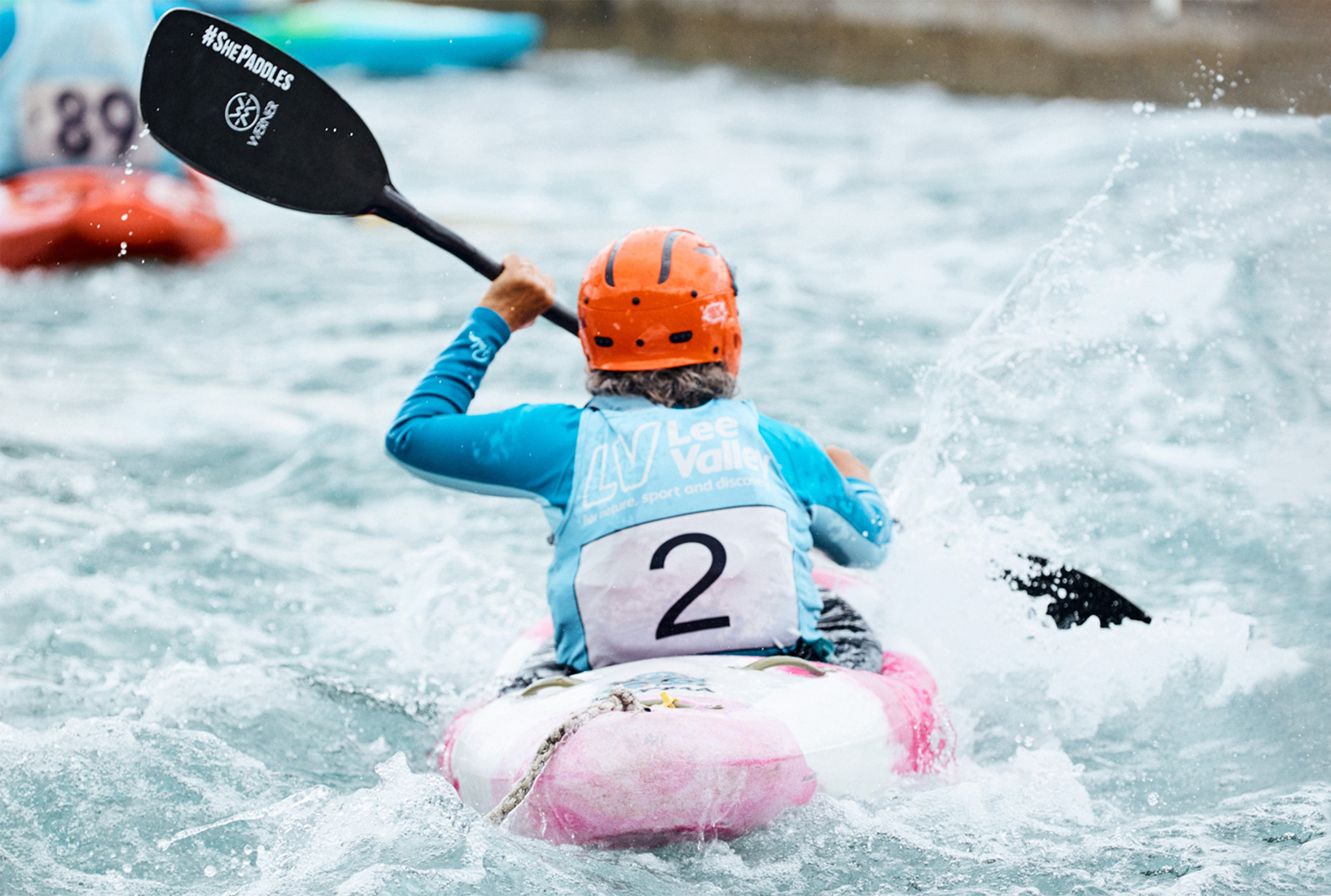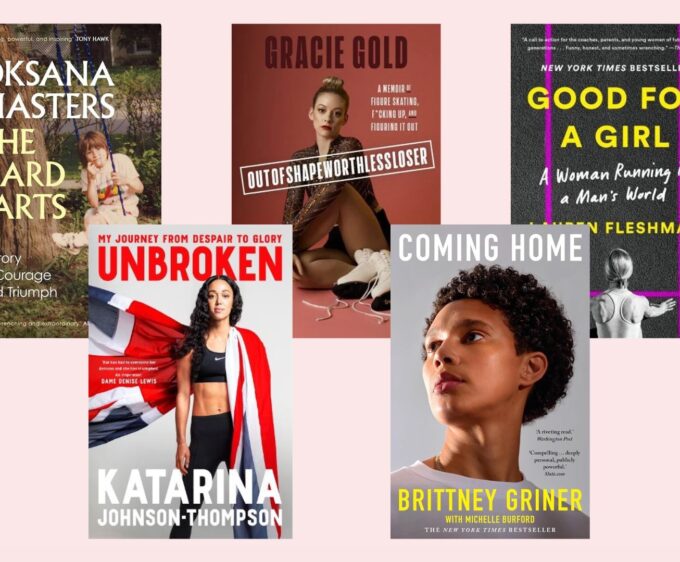
Water Wonder
Unlike others her age, kayaker Pam Phillips refuses to disappear from public view. Here we talk to her about finding this adventure sport later in life
By Anna Dimond
Photography by Gemma Gravett
Seven years ago, when Pam Phillips signed up for a kayaking course near her home in Lee Valley, just north of London, she had never even sat in a kayak before. Aged 65 at the time, she was barely a year into her retirement and was already occupied with activities she enjoyed, from jogging to badminton and even some Zumba. Besides, she suffers from poor circulation and cold water wasn’t really her thing.
But when she received an email about lessons at the Lee Valley White Water Centre, a world-class facility built for the 2012 London Olympics, one thing caught her eye.“It was free,” she says. Indeed, the class was sponsored by Sport UK as part of ‘This Girl Can,’ a campaign to get more women and girls into physical activity. That one class changed the trajectory of Pam’s life.

“From the first session, I just fell in love with it,” she says. “I don’t know what it was. Achievement, freedom. It was something that I could do for myself, on my doorstep. At an Olympic facility where history was made. And of course,” she adds, “from there, the obsession just took hold.”
From learning to find her balance in the boat to proper paddling technique on flat water, Pam progressed to courses on white water, in which water flows rapidly through a river with rocks and banks. At the Lee Valley facility, students learn on a narrow, manufactured passage with plastic blocks to mimic real-life obstacles and rapids. She learned to roll the kayak, a technique to turn a boat (and its paddler) upright when it capsizes, and to release the skirt of the boat, which keeps her in her seat and water out, and swim to the side if rolling doesn’t work. Pam began to make new friends at the centre, meeting up with people who paddled when she did and becoming secretary of the Lee Valley Paddlesport Club. Now 72, with bouncy grey curls that overflow from her helmet (picture a motorcycle helmet, minus the face shield), she’s become known to paddlers locally and beyond. Some of her fellow kayakers call her “Nanny,” while others identify her on area waterways.
Of her regional renown, Pam says, she’s “constantly surprised” by the recognition. “If people are inspired, then that’s fantastic. And they’re interested [in kayaking], that’s also fantastic.” (She suspects that her hair is always the identifying giveaway.)
As her skill level and competence increased, so did her range of rapids and experiences. She began taking an annual kayaking trip to the Scottish Highlands with her paddling friends, and tackling rapids with stronger currents and more obstacles. Over time, she was able to advance from paddling rapids rated Class II or III – moderately difficult river runs – to Class V. Paddling.com, a website dedicated to the sport, describes Class V as “Extremely difficult. Long and violent rapids that follow each other almost without interruption. River filled with obstructions. Big drops and violent currents. Extremely steep gradient.”


One moment stands out for Pam as the epitome of her experience so far, and as the culmination of her near-daily paddle sessions. Just before her 70th birthday, she passed her paddling assessment for the Lee Valley White Water Centre’s Olympic course. It’s the same course that professional athletes navigated during the 2012 Games, and at the centre, paddlers are required to perform a set of skills on the course – akin to a driving test – before they can paddle it without oversight. Pam’s test administrator was the same coach with whom she’d begun taking classes five years before, and who had continued to coach her throughout her kayaking journey. During the hour-long assessment, she had to demonstrate skills like paddling into and out of an eddy for safety, avoiding other kayakers on the course, and showing that she could self-rescue in the case of capsizing. She spent three years preparing for the exam.
“When (my coach) told me I’d passed,” she says, “I just burst into tears. I mean, I’ve got three kids, I’m very proud of them, but I really was proud of that achievement. I’m the oldest person to pass that assessment. There are older people who paddle on the Olympic (course), but they’re people who have been paddling for more than 20 years.” Despite the challenges, Pam was never scared. A self-described “adrenaline junkie” who loves roller coasters and physical challenges, she attributes her immediate comfort in the boat to her years riding horseback as a kid. Horses were her first love and consumed her then as much as kayaking does now. “I tend to be a ‘stayer,’” she says. “When I first started riding, my dad said, ‘We’re not going to start investing in this because it will be a one-two minute wonder.’ Lots of children pick up things and drop them again. But I rode for 14 years and my pony was my life. I never had boyfriends and nice clothes.”

Adventurous

Pam did, eventually, trade her pony not for a boyfriend, but a husband, at 22. They had three children and she began working full-time as a physiotherapist for the National Health Service. For the next few decades, her passions took a back seat to those of her family. She and her first husband split and she married again and continued to work until she was 64. Throughout Pam’s kayaking journey, there’s been just one time when fear crept into the proceedings. In September 2020, she capsized on one of the centre’s courses at such an angle that she cut her eye on one of the plastic blocks under the water. She had a black eye for weeks and for the first time since she’d begun paddling, felt nervous about returning to the water. The worst part, though, was that her husband had seen the accident happen. “He doesn’t normally come to see me because he doesn’t like to see me get hurt. And I said, ‘Come on, I’m fine! I’m really paddling well these days, you don’t have to worry.’”

It took Pam a few weeks to recover, and she recalled her first day back at the centre once her eye had healed. Heading up the escalator to the start of the course, she felt trepidation, nervousness and anxiety. Yet, her anxiety was short-lived and soon enough, she was back to her rigorous paddling schedule and taking on the rapids. Despite Pam’s palpable passion for the sport, so far no one else in her family has caught the kayaking bug. Her husband tried kayaking a few times, and one of her grandsons has joined her, too. But her eldest daughter won’t even come to see Pam in her element on the water, out of fear of seeing her mother get hurt. Pam’s other six grandchildren are more into football and horses than paddling so kayaking is entirely her own pursuit.
At the centre, though, Pam has found like-minded friends whose ages run the gamut. So far she’s felt nothing but open arms. Kids and other paddlers used to offer her tips when she was learning to kayak, and on trips her friends have offered to carry her boat for her to and from the water (she declines). She knows that women are vastly outnumbered in the sport – she estimates that at the centre, male paddlers outnumber females by three or four to one. But progress, she noted, is relative.

Growing up her father didn’t do the washing-up, or even set foot in the kitchen. Today, her husband is perfectly capable of doing the dishes. And she pointed to the type of supportive, sporting community that’s available for women now, in contrast to when she was growing up. In 2018, British Canoeing, the UK’s membership and development organisation for paddlesports, chose 10 female ambassadors, including Pam. Among the programmes and activations that the organisation created was a Facebook group for women paddlers and would-be paddlers. To Pam, the group’s mere existence signals evolution for women’s place in the world. The female-focused discussion on the group page is a step further. “It’s been many, many years since I had a period of course, but you know, people were [asking] ‘What do you do when you’ve got a period and you’re kayaking,?’” she says. “I never assumed that there would be a platform for women to express personal views about things in a sport.”
Still, she acknowledges that there is work to be done. That, particularly as women age, they tend to disappear from public view. It’s largely for that reason, she believes, that her devotion to kayaking has garnered attention. “I think it shows that you know if you want to do something, and you’re lucky enough to have good health, you can do it,” she says. “People come up to me and say, ‘Oh, you’re amazing.’ I’m not. I’m very, very blessed. I’m strong and fit, thank God. And I’m very chatty and approachable, and I do spread the word about kayaking because I absolutely love it.” It’s that love that, ultimately, lies at the heart of Pam’s devotion to kayaking. “It’s you against the river, so I’m trying to prove myself,” she says. “It’s probably very egotistical, but I’m trying to be better than the water. “I’m not a philosopher. All I know is that (kayaking) gives me a wonderful feeling. I love being out in nature and in the open. When I’m on a river in Wales, for example, and it’s the most beautiful scenery and there’s ducks on the water and birds are singing, it’s total bliss.”

Editorial Design Root
For further information on kayaking and all paddle sports, visit British Canoeing








